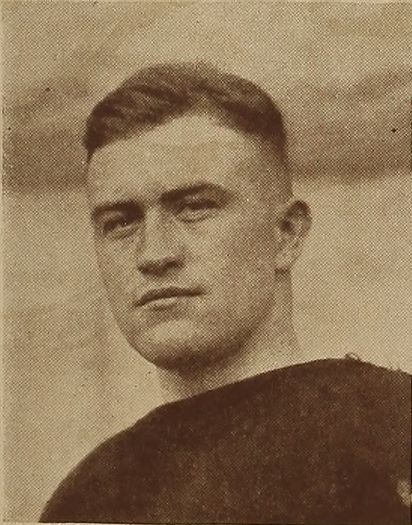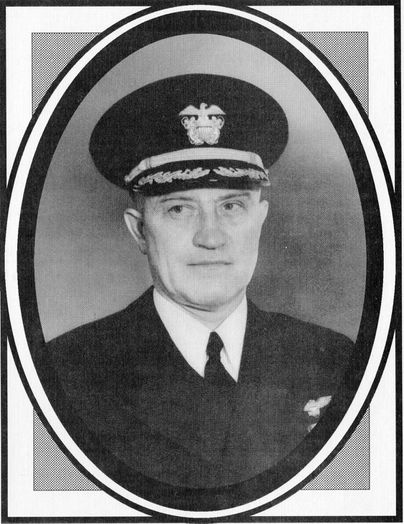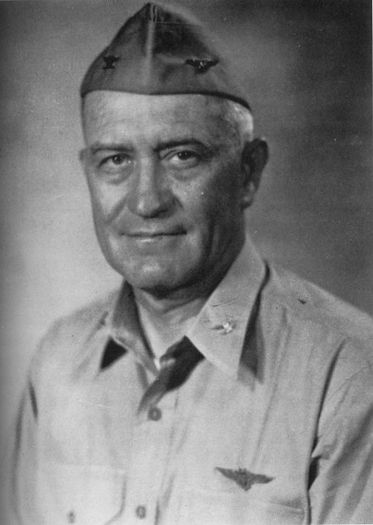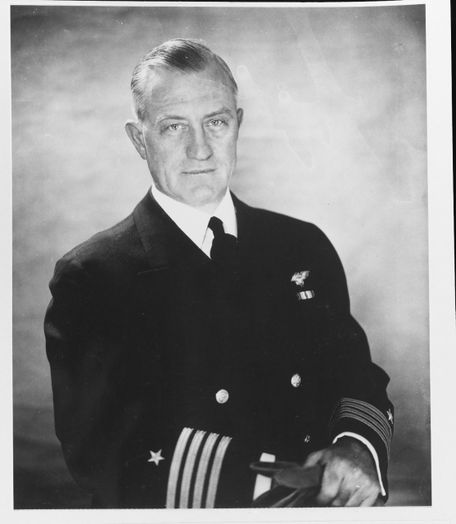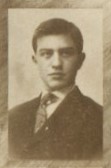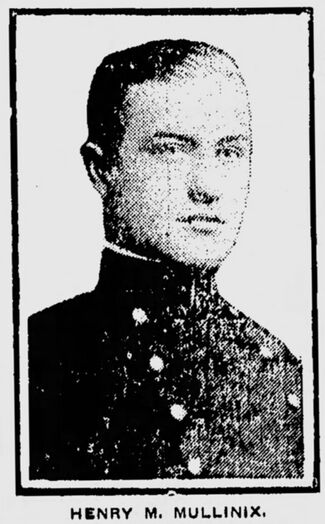HENRY M. MULLINNIX, RADM, USN
Henry Mullinnix '16
Lucky Bag
From the 1916 Lucky Bag:
Henry Maston Mullinnix
Attica, Indiana
"Henry" "Heinie"
A SLIGHT paraphrasing of the maxim of the exponents of the strenuous life to make it read "When he works, he works hard; and when he plays, he works hard," sums up Henry's attitude toward Academy life. He is a worker in everything he tackles. Do you remember him in football last fall? Was there a man on the squad who gave more than he? When he went after a forward pass it was with a determination to get it, and if, by any chance, he failed once, it was a pretty safe bet that he'd get it next time.
He wears his star not so much on account of any uncanny savviness, but because of that same concentration. When he sits down to bone in a study hour, it is to bone, and to bone hard. But let a wooden man come in—or a savoir, either, for they all go to Henry for help—down goes his book and he'll spend the hour, if need be, in clearing up the hazy points for his less fortunate friends.
Naturally rather reticent, he prefers a well-regulated existence and a quiet habitation, but for four years his peace of mind, and body too, has been rudely disturbed by Rosie. So violent were the upheavals Youngster Year, that the whole corridor expected to see "Dot German Boy" come flying through the door, but Heinie has learned to take such riots philosophically and he now devotes his endeavors to taking a paternal interest in Rosie's welfare.
His quiet reserve has prevented his making many close friends, but those who know him beyond the mere acquaintanceship stage have found him a man, and one well worthy to be held a friend.
Five stripes adorn his sleeve because he rates them, and he has handled the duties of Senior Midshipman Officer in a manner that has fully justified the confidence the authorities placed in him, and which has opened the eyes of many of his classmates to his true worth.
Wherever Henry goes in the Service, his ship will be the gainer by one efficient, reliable officer.
Star (3, 2, 1); Five Stripes; Football Numerals; Soccer Numerals; Varsity Football (2, 1); Sharpshooter; Class German Committee.
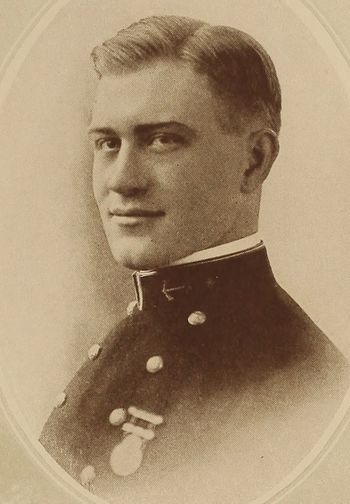
Henry Maston Mullinnix
Attica, Indiana
"Henry" "Heinie"
A SLIGHT paraphrasing of the maxim of the exponents of the strenuous life to make it read "When he works, he works hard; and when he plays, he works hard," sums up Henry's attitude toward Academy life. He is a worker in everything he tackles. Do you remember him in football last fall? Was there a man on the squad who gave more than he? When he went after a forward pass it was with a determination to get it, and if, by any chance, he failed once, it was a pretty safe bet that he'd get it next time.
He wears his star not so much on account of any uncanny savviness, but because of that same concentration. When he sits down to bone in a study hour, it is to bone, and to bone hard. But let a wooden man come in—or a savoir, either, for they all go to Henry for help—down goes his book and he'll spend the hour, if need be, in clearing up the hazy points for his less fortunate friends.
Naturally rather reticent, he prefers a well-regulated existence and a quiet habitation, but for four years his peace of mind, and body too, has been rudely disturbed by Rosie. So violent were the upheavals Youngster Year, that the whole corridor expected to see "Dot German Boy" come flying through the door, but Heinie has learned to take such riots philosophically and he now devotes his endeavors to taking a paternal interest in Rosie's welfare.
His quiet reserve has prevented his making many close friends, but those who know him beyond the mere acquaintanceship stage have found him a man, and one well worthy to be held a friend.
Five stripes adorn his sleeve because he rates them, and he has handled the duties of Senior Midshipman Officer in a manner that has fully justified the confidence the authorities placed in him, and which has opened the eyes of many of his classmates to his true worth.
Wherever Henry goes in the Service, his ship will be the gainer by one efficient, reliable officer.
Star (3, 2, 1); Five Stripes; Football Numerals; Soccer Numerals; Varsity Football (2, 1); Sharpshooter; Class German Committee.
Loss
Henry was lost on November 24, 1943 when USS Liscome Bay (CVE 56) was torpedoed and sunk by a Japanese submarine. He was embarked as the Commander of Carrier Division (CARDIV) 24.
Biography
From Naval History and Heritage Command:
Born 4 July 1892, in Spencer, Indiana, Henry Maston Mullinnix was graduated from the grammar and high schools of Attica, Indiana, and attended Purdue University, Lafayette, Indiana, for one year as a member of the Class of 1915. He was appointed to the US Naval Academy from his native state in 1912, and was graduated with distinction and commissioned Ensign on 2 June 1916, standing first in a class of 177 members. During World War I he was promoted to Lieutenant (junior grade) and Lieutenant in 1917, and was commissioned in those ranks in 1919 and 1920, respectively. Subsequently promoted to Lieutenant Commander 1 July 1926, Commander, 30 June 1936, and Captain 1 July 1941, he attained the rank of Rear Admiral on 6 August 1943, to date from 13 November 1942.
After graduation from the Naval Academy in 1916, he was assigned to USS Balch, which operated with the Destroyer Force based on Queenstown, Ireland, late in 1917, and during the remainder of World War I was employed in patrol and escort duty in the War Zone. He returned to the United States in September 1918, and after assisting in fitting out USS Gridley at Union Iron Works, San Francisco, California, he served as Engineer Officer of that destroyer from her commissioning on 27 August 1918, until March 1920. He next assisted in fitting out USS Brooks at the New York Shipbuilding Company, Camden, New Jersey, and served as her Engineer Officer from her commissioning 24 August 1920 until 13 May 1921.
During the period June 1921 to June 1923 he was a student in Aeronautical Engineering at the Postgraduate School, Annapolis, and Massachusetts Institute of Technology, Cambridge, Massachusetts, receiving the degree of Master of Science from the latter. He then had flight training at the naval Air Station, Pensacola, Florida, where he was designated Naval Aviator on 11 January 1924.
Assigned to the Engine Section of the Bureau of Aeronautics, Navy Department, Washington, DC, from June 1924 until September 1927, he next had duty in connection with fitting out USS Saratoga (CV-3), and served in that aircraft carrier from her commissioning on 16 November 1927 until 27 June 1929, first as Assembly and Repair Officer, and later as Assistant Air Officer. During the following year he commanded Bombing Squadron Two of Aircraft Squadrons, Battle Fleet, based on USS Saratoga.
From June 1930 until June 1932, he served on the Staff at the Naval Air Station, Pensacola, and after a year's duty on the Staff of Commander Aircraft, Scouting Force, served as Navigator of the Fleet Air Base, Pearl Harbor, T. H., from June 1934, until May 1937, then he returned to USS Wright for duty as Executive Officer until June 1938. During the next year he served as Aviation Officer on the Staff of Commander Battle Force, and for a year thereafter he was ashore as Executive Officer of the Naval Air Station, San Diego, California.
On 1 November 1940, he reported at the New York Shipbuilding Corporation, Camden, New Jersey, to fit out USS Albemarle. He commanded that seaplane tender from her commissioning 20 December 1940, until 3 March 1941. He commanded the patrol Wing of the Support Force (later redesignated Patrol Wing Seven) for a year and received the following Letter of Commendation from the Secretary of the Navy:
"The Department has been informed that during the period from March 3, 1941 to March 21, 1942, you, as Commander Patrol Wing Seven and Commander patrol Wings, support force, conducted the equipping, specialized training, and operations of patrol aircraft of the Support force (TF-24) in high latitude operation and anti-submarine and escort-of-convoy tactics which contributed to the safe escort of shipping in the vicinity of Newfoundland and Iceland. For your outstanding performance of duty during this period, you are hereby commended."
He served as Air Officer on the Staff of Commander Eastern Sea Frontier, from March 1942 until March 1943, and for his achievements during that period was awarded the following Letter of Commendation from the War Department: "From early 1942 until his recent departure to another assignment, it was my pleasure to be associated with Captain Mullinnix in the conduct of Antisubmarine Air Operations. I wish to commend Captain Mullinnix for his excellent judgment, tact, personality and understanding of the problem at hand. His services rendered during this period contributed greatly to the success of the operations."
In the rank of Captain he commanded the aircraft carrier USS Saratoga from 7 April 1943 until 22 August 1943, when he was ordered to command a Carrier Division, with the accompanying rank of Rear Admiral. He was aboard USS Liscome Bay as Task Force Commander when that aircraft carrier escort was torpedoed and sunk by an enemy submarine off Makin Island in the Gilbert Islands area, on 24 November 1943, and was reported missing in action following that catastrophe. He was officially declared dead a year later. He was posthumously awarded the Purple Heart Medal for wounds received, and the Legion of Merit, with the following citation:
Legion of Merit: "For exceptionally meritorious conduct...as Commander of a Carrier Air Support Group prior to and during the amphibious invasion of Japanese-held Makin Atoll, Gilbert Islands, from November 1 to 24, 1943. Displaying outstanding initiative and superior executive ability, Rear Admiral Mullinnix skillfully conducted anti-submarine and combat air patrols supporting our landing operations on this strongly defended island and, through his brilliant leadership, enabled escort carriers to carry out a well coordinated, aggressive attack against the enemy. Rear Admiral Mullinnix's tireless efforts, meticulous attention to detail and loyal devotion to the accomplishment of an extremely difficult and hazardous mission contributed materially to out subsequent capture of this strategic area."
In addition to the Legion of Merit with Combat "V," the Purple Heart Medal, and the Commendation Ribbon, Rear Admiral Mullinnix had the World War I Victory Medal, Destroyer Clasp; and was entitled to the American Defense Service Medal, Fleet Clasp; the Asiatic-Pacific Campaign Medal; and the World War II Victory Medal.
USS Mullinnix (DD-944) was named in his honor and an airfield on Buota Island, Tarawa, in the Gilbert Islands, was also named "Mullinnix Field" in honor of the late Rear Admiral Mullinnix.
Other Information
From researcher Kathy Franz:
Henry was president of his junior class at Attica High School. Henry recited the oration “Cyrus Field and the Atlantic Cable” at an assembly on February 28, 1908. In the yearbook, Henry’s “word portrait” was “Unknit that threatening unkind brow, it blasts they beauty as a frost do bite the mead.”
Henry graduated in 1909, and his bio read: President, Treasurer of Tennis Association ’06-’07-’08-’09. Junior Play ’08, Football ’08, Glee Club ’08-’09, Editor-in-chief of Crimson ’09, Senior Play ’09. “Some’ow I don’t mind talking about myself.” In the senior play, “A Great Catastrophe,” Henry played Dennis Milliken, the butler. “Henry Mullinnix, the stupid Irish butler, furnished the comedy of the play and proved to be quite equal to the occasion.” From the class chronology: November 17: “We learn in physics that hot air caused anything that contained enough of it to rise. Several students immediately think it necessary to attach weights to Henry Mullinnix.”
His yearbook included the Phrenological Forecast:
Senor President, the roll of your lofty brow signifies great individuality, and the swelling protuberances above your temples indicate ideality and great conceptive ability. Surely you will be famous as a scientist and mathematician. Only persevere and you may even discover the fourth dimension in your mighty researches.” Class Will: Tenth: I, Henry Mullinnix, give, devise and bequeath to Olive Shideler, my vocabulary. I hope that with the combination of mine and Webster’s you may be able to publish one of your own.
A Toast to Our President
Have you heard of that storehouse of wisdom,
The boy with the pen and ink,
Who rules o’er all the Seniors
And who seems to be made of ‘think’?The sages of old were mighty
But their fame is of the past;
Our Henry belongs to the present
And he’s got ‘em all out-classed.They gaze upon him in wonder,
As he walks beneath the trees;
The weight of his head, is such, ‘tis said,
That his legs bow out at the knees.He edits the ’09 Crimson
And writes jokes with no point at all;
But we’ll not forget, he’s our president yet,
And we love him in spite of it all.Then here’s to the whip of the school,
The lad who controls with kicks,
We’ll drink his health and wish him wealth
The Honorable H. Mullinnix.In June 1914, Henry was at the top of the Naval Academy’s second class. He was one of five members of the class entitled to a star rating, a mark of 85 or better.
In August 1918, Henry sailed from Liverpool to New York City.
He married Kathryn O’Neil on September 2, 1919, in Manhattan, New York. She died October 1973, in San Joaquin, California.
In December 1920, his wife sailed to join him in Constantinople. He was stationed on the USS Brooks cruising in the Mediterranean.
In September 1923, Henry’s brother Lieutenant Allen escaped injury when the destroyer Delphy was grounded at San Diego.
Henry himself was injured slightly on March 17, 1924, when two planes collided in mid air 1500 feet above the Corry flying field at Pensacola. Lieutenants Charles Porter (’20) and Olin Miner (’20) were killed. Henry righted his plane after the collision. His occupant Lieutenant Thomas Fisher (’18) was injured slightly.
On May 28, 1930, Henry gave a short talk to the Attica Kiwanis club about his exploits on the U. S. air craft carrier Saratoga.
In June 1934, Henry sailed from Los Angeles to Honolulu. His wife joined him in July. In April 1935, his wife’s mother visited them at Pearl Harbor where he was a commander.
In February 1938, Henry was named chairman on the board of inquiry for the collision of two patrol bombers, the 11-P-3 and 11-P-4, off the coast of California. Henry was from the flagship Wright, aircraft scouting force.
His father William F. was a teacher and principal who became superintendent of schools. Henry’s mother was Edith, brother Allen, and sisters Mary (Mrs. Bruce Dolch) and Katherine.
His wife, Kathryn, was listed as next of kin. He has a memory marker in Indiana.
Remembrances
From "Twenty-Three Minutes to Eternity: The Final Voyage of the Escort Carrier USS Liscome Bay":
By now Mullinnix was in the carrier's flag plot, keeping a watchful eye on the charting of the division's course for the upcoming day. The admiral had been up for days, catching rare snatches of sleep, and was bone-tired. "He was a terrifically hard worker and the most conscientious man I ever saw," his chief of staff [John Crommelin] later wrote. Mullinnix's flag quartermaster, P.W. Rairden, joined the admiral in the plot. The admiral had become known among the ship's sailors by then as a "kind, friendly man," and the two men shared a few moments of quiet conversation as the ship around them slowly came to life.
From the May 1957 issue of Shipmate:
The following address was delivered by V. Adm. George F. Hussey, USN (Ret.) '16, on the occasion of the launching of the USS MULLINNIX (DD-944) on 18 March 1957.
"Forty-five years is a long span. In this setting it takes some of us back to the old three-stack destroyers that made up our light forces before World War I. This ship before you looks as if she could hoist in one of those old-timers.
"For the Class of 1916 that span evoke many memories. Sharp among them is the recollection of a sturdy, broad-shouldered Middlewesterner with a shock of blond hair. It was early apparent that he had an excellent mind and a prodigious power of concentration. Whatever he undertook he gave it all his energy—on the football field as in the classroom. Standing well up near the top of the class Plebe Year, he went on to stand No. One for the next two years, and at graduation he led the class as our honor man. First Class Year he wore the five stripes of the Midshipman Commander, the highest billet in the Regiment. The Lucky Bag, edited by his classmates, noted that 'he wore those stripes because he rated them.' That from one midshipman to another is high praise. With all his concentration he was never too busy to drop his own work and lend a hand to those of us who were making heavy weather of the course. That midshipman was Henry Maston Mullinnix.
"Graduation saw a new departure by the Bureau of Navigation—a handful of the class were assigned to destroyers. Henry went to one—one of those old three-stackers —and served before World War I and in the war at Queenstown in the joint British-American anti-submarine and convoy escort operations. Toward the end of the war he came back to commission one of the new four-stack destroyers, and after a couple of years to do the same with another, in each serving as Engineer Officer.
"In the summer of 1921 he began a course in Aeronautical Engineering at the Postgraduate School, followed by a year at Massachusetts Institute of Technology (which the Navy always called 'Boston Tech') where he won a Master of Science degree. Then one of the first officers to be trained in aeronautical engineering he went to Pensacola and in January 1924 qualified as a Naval Aviator. During more than three years in the Engine Section of the Bureau of Aeronautics he took a leading part in the development of the air-cooled engine for naval aircraft. He fitted out the Saratoga and served in her as a ship's officer and later in command of her bombing squadron.
"The next ten years saw Henry Mullinnix as a lieutenant commander and a commander serving on various staffs, at Naval Air Stations, and in aircraft tenders. Those years were of vital importance to the development of naval aviation, and in each billet Henry took a leading part. He commissioned the Aircraft Tender Albemarle in 1940, but his command was short for he was assigned to the greater responsibility of Commander Patrol Wing Seven. His Catalina squadrons were concerned with convoy escort and anti-submarine operations from Argentia and Iceland and in the high latitudes of the Atlantic. He was back at his old trade, with new tools to his hand. His performance in organization, training, and operations won him commendation from the Secretary of the Navy, and assignment to even broader responsibilities as Air Officer, Eastern Sea Frontier. Here he was concerned with anti-submarine operations on the whole Atlantic Coast. Here again his performance won him commendation—this time from the War Department.
"Another short command—his old ship the Saratoga—came to an end when he was promoted to Rear Admiral and assigned command of a division of Escort Carriers. These were a relatively new type being introduced into the amphibious operations in the Pacific.
"He commanded Task Group 53.2 in the Gilbert Islands Campaign. His group was a part of Admiral Turner's Task Force which made the attack on Makin Island—the planes from his carriers furnishing direct support for the landing and to the Army troops ashore. At dawn on the fourth day his flagship, the Liscombe Bay, was torpedoed by a Japanese submarine. The ship went down astoundingly quickly with an appalling loss of life—including Admiral Mullinnix.
"There the Service lost a splendid officer with a brilliant career behind him and the promise of many more years of leadership.
"May this fine ship—the product of so many keen minds, skilled hands, and stout hearts—which will bear his name, serve as an inspiration to all who serve in her to emulate Henry Mullinnix in his devotion to duty and his singleness of purpose—the good of the Service."
Photographs
From Find A Grave
From Find A Grave
"First Commanding Officer, USS ALBEMARLE (AV-5) (20 December 40-4 March 41)." From Naval History and Heritage Command
Legion of Merit
From Hall of Valor:
The President of the United States of America takes pride in presenting the Legion of Merit (Posthumously) to Rear Admiral Henry Maston Mullinnix (NSN: 0-9700), United States Navy, for exceptionally meritorious conduct in the performance of outstanding services to the Government of the United States as Commander of a carrier air support group during the assault on Makin Atoll during World War II. Admiral Mullinnix skillfully conducted anti-submarine and combat air patrols supporting our landing operations. Through his brilliant leadership, escort carriers were able to carry out a well coordinated attack against the Japanese.
General Orders: American Battle Monuments Commission
Service: Navy
Rank: Rear Admiral
Prior Accidents
On March 17, 1924 he survived a mid-air collision with another aircraft near Pensacola, Florida. Thomas Fisher '18 also survived, but Charles Porter '20 and Olin Miner '20 were both killed.
The "Register of Commissioned and Warrant Officers of the United States Navy and Marine Corps" was published annually from 1815 through at least the 1970s; it provided rank, command or station, and occasionally billet until the beginning of World War II when command/station was no longer included. Scanned copies were reviewed and data entered from the mid-1840s through 1922, when more-frequent Navy Directories were available.
The Navy Directory was a publication that provided information on the command, billet, and rank of every active and retired naval officer. Single editions have been found online from January 1915 and March 1918, and then from three to six editions per year from 1923 through 1940; the final edition is from April 1941.
The entries in both series of documents are sometimes cryptic and confusing. They are often inconsistent, even within an edition, with the name of commands; this is especially true for aviation squadrons in the 1920s and early 1930s.
Alumni listed at the same command may or may not have had significant interactions; they could have shared a stateroom or workspace, stood many hours of watch together, or, especially at the larger commands, they might not have known each other at all. The information provides the opportunity to draw connections that are otherwise invisible, though, and gives a fuller view of the professional experiences of these alumni in Memorial Hall.
January 1917
March 1918
January 1919
January 1920
January 1921
January 1922
May 1923
July 1923
September 1923
November 1923
January 1924
March 1924
May 1924
July 1924
September 1924
November 1924
January 1925
March 1925
May 1925
July 1925
October 1925
January 1926
October 1926
January 1927
April 1927
October 1927
January 1928
April 1928
July 1928
October 1928
January 1929
April 1929
July 1929
LTjg Theodore Marshall '24 (USS Saratoga)
LTjg Charles McDonald '24 (Torpedo and Bombing Plane Squadron (VT) 2B)
LTjg Creighton Lankford '25 (Fighting Plane Squadron (VF) 1B)
ENS Henry Dozier '27 (USS Saratoga)
ENS Henry Twohy '29 (USS Saratoga)
October 1929
LTjg Charles McDonald '24 (USS Saratoga)
LTjg Creighton Lankford '25 (Fighting Plane Squadron (VF) 1B)
January 1930
LTjg Hubert Waters '25 (Aircraft Squadrons, Battle Fleet)
LTjg Creighton Lankford '25 (Fighting Plane Squadron (VF) 1B)
LTjg Charles Signer '26 (Torpedo and Bombing Plane Squadron (VT) 2B)
LTjg Claude Haman '26 (Scouting Plane Squadron (VS) 2B)
ENS Loren Morris '27 (Aircraft Squadrons, Battle Fleet)
ENS John Eldridge, Jr. '27 (Aircraft Squadrons, Battle Fleet)
ENS Eugene Lindsey '27 (Aircraft Squadrons, Battle Fleet)
ENS Julian Greer '27 (Aircraft Squadrons, Battle Fleet)
ENS Henry Twohy '29 (USS Saratoga)
April 1930
LT John Jones '21
LTjg William Davis '22
LT James Craig '22
LTjg Matthias Marple, Jr. '23
LTjg Theodore Marshall '24
LTjg Walter Dey '24
LTjg James McDonough '24
LTjg John Waldron '24
LTjg Andrew Harris '25
October 1930
LT Irving Wiltsie '21
LTjg Matthias Marple, Jr. '23
LTjg Robert Larson '24
LTjg James McDonough '24
LTjg John Waldron '24
LTjg Charles McDonald '24
LTjg Richard Moss '24
1LT Donald Willis '24
January 1931
LT Irving Wiltsie '21
LTjg Matthias Marple, Jr. '23
LTjg Robert Larson '24
LTjg James McDonough '24
LTjg John Waldron '24
LTjg Charles McDonald '24
LTjg Richard Moss '24
LTjg John Duke '26
LTjg James Averill '27
April 1931
LTjg Matthias Marple, Jr. '23
LTjg Robert Larson '24
LTjg James McDonough '24
LTjg John Waldron '24
LTjg Charles McDonald '24
LTjg Richard Moss '24
LTjg John Duke '26
LTjg James Averill '27
LTjg William Potts '27
ENS Carl Lindgren '28
July 1931
LTjg Matthias Marple, Jr. '23
LTjg Robert Larson '24
LTjg James McDonough '24
LTjg Charles McDonald '24
LTjg Richard Moss '24
LTjg Carlton Hutchins '26
LTjg Charles Signer '26
LTjg John Duke '26
LTjg William Potts '27
ENS Carl Lindgren '28
October 1931
LTjg Matthias Marple, Jr. '23
LTjg Robert Larson '24
LTjg James McDonough '24
LTjg Charles McDonald '24
LTjg Arthur Farrell '25
LTjg Carlton Hutchins '26
January 1932
LT Irving Wiltsie '21
LTjg Matthias Marple, Jr. '23
LTjg Robert Larson '24
LTjg James McDonough '24
LTjg Charles McDonald '24
LTjg Arthur Farrell '25
LTjg Carlton Hutchins '26
LTjg Charles Signer '26
April 1932
LT Irving Wiltsie '21
LTjg Matthias Marple, Jr. '23
LTjg Robert Larson '24
LTjg James McDonough '24
LTjg Charles McDonald '24
LTjg Arthur Farrell '25
LTjg Carlton Hutchins '26
LTjg Charles Signer '26
2LT Lofton Henderson '26
October 1932
LT Edwin Crouch '21 (USS Lexington)
LT William Ault '22 (Torpedo and Bombing Squadron (VT) 1S)
LTjg Eugene Lindsey '27 (USS Lexington)
LTjg Henry Twohy '29 (Fighting Plane Squadron (VF) 5S)
ENS John Yoho '29 (Scouting Plane Squadron (VS) 3S)
ENS Edwin Kelly '30 (Torpedo Squadron (VT) 1B)
ENS Walter Bailey '31 (USS Lexington)
ENS Eugene Lytle, Jr. '31 (USS Lexington)
ENS John Fairbanks, Jr. '32 (USS Lexington)
ENS Daniel Gothie '32 (USS Lexington)
ENS Albert Major, Jr. '32 (USS Lexington)
ENS William Thorn '32 (USS Lexington)
January 1933
LT Edwin Crouch '21 (USS Lexington)
LT William Ault '22 (Torpedo and Bombing Squadron (VT) 1S)
LTjg Eugene Lindsey '27 (USS Lexington)
LTjg Henry Twohy '29 (Fighting Plane Squadron (VF) 5S)
ENS John Yoho '29 (Scouting Plane Squadron (VS) 3S)
ENS Edwin Kelly '30 (Torpedo Squadron (VT) 1B)
ENS Victor Gaulin '30 (Scouting Plane Squadron (VS) 3S)
ENS Walter Bailey '31 (USS Lexington)
ENS Eugene Lytle, Jr. '31 (USS Lexington)
ENS John Fairbanks, Jr. '32 (USS Lexington)
ENS Daniel Gothie '32 (USS Lexington)
ENS Albert Major, Jr. '32 (USS Lexington)
ENS William Thorn '32 (USS Lexington)
April 1933
July 1933
October 1933
April 1934
July 1934
October 1934
January 1935
April 1935
October 1935
January 1936
April 1936
July 1936
January 1937
April 1937
September 1937
January 1938
July 1938
LTjg Dewitt Harrell '35 (USS California)
ENS Earl Cassidy '37 (USS California)
ENS Hugh Rimmer '37 (USS California)
ENS Green Goodloe '37 (USS California)
ENS West Payne '38 (USS California)
ENS Donald Hamilton, Jr. '38 (USS California)
January 1939
LTjg Dewitt Harrell '35 (USS California)
ENS Robert Bonin '36 (Battle Force, US Fleet)
ENS Hugh Rimmer '37 (USS California)
ENS West Payne '38 (USS California)
ENS Donald Hamilton, Jr. '38 (USS California)
October 1939
June 1940
November 1940
April 1941
Related Articles
Irving Wiltsie '21, Lester Kern '23, Finley Hall '29, Charles Ostrom '30, and George Williams '40 were also lost in Liscome Bay.
Namesake
USS Mullinnix (DD 944) was named for Henry; the ship was sponsored by his widow.
Memorial Hall Error
On the killed in action panel in the front of Memorial Hall Henry's last name is spelled with only one "n".

The "category" links below lead to lists of related Honorees; use them to explore further the service and sacrifice of alumni in Memorial Hall.
